| |
|
Saturday, May 17 Tifereth Israel Synagogue—Dizengoff Night


Sunday, May 18 Community Israel Independence Celebration

Wednesday, May 28 JFS~Ellen Saks lecture on mental illness
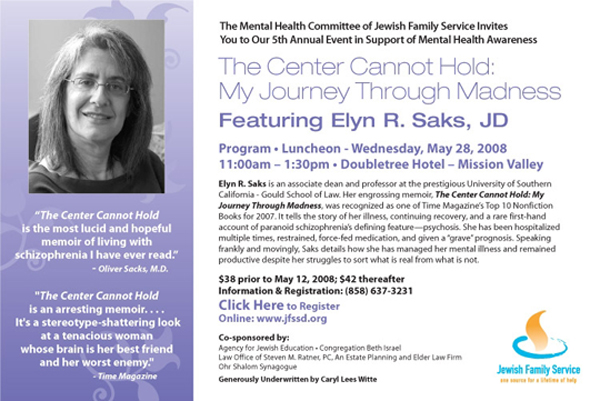

Tuesday, June 3 Guardians Golf & Tennis Tournament


Friday-Saturday, June 6-7 JFS~Judaism on the Wild Side

Sunday, June 8 Temple Solel~Tikkun Leil Shavuot


THE VIEW FROM JINSA
Europe is fatigued by moral issues like the Holocaust, Israel's existence
By Shoshana Bryen
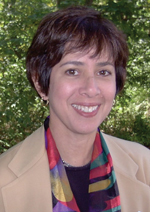 WASHINGTON, D.C.—Europe is tired of Jews. Not all Europeans, of course, and we hope for a new trend with the ascension to power of Merkel, Szarkozy and Berlusconi (and an old friend, Fiamma Nierenstein, to the Italian Parliament) and the dumping of Red Ken Livingstone as Mayor of London. But in general, Europeans are tired of their own history and unwilling to fight for their own principles. They now reject additional troops for Afghanistan; even as they agree the fighting there is essential. And as they appear to want only to be left alone, Jews make it hard and Israel makes it harder. WASHINGTON, D.C.—Europe is tired of Jews. Not all Europeans, of course, and we hope for a new trend with the ascension to power of Merkel, Szarkozy and Berlusconi (and an old friend, Fiamma Nierenstein, to the Italian Parliament) and the dumping of Red Ken Livingstone as Mayor of London. But in general, Europeans are tired of their own history and unwilling to fight for their own principles. They now reject additional troops for Afghanistan; even as they agree the fighting there is essential. And as they appear to want only to be left alone, Jews make it hard and Israel makes it harder.
The Holocaust remains a singular crime against humanity, planned and organized by Nazis, but willingly advanced by others all across Europe. Many 21st Century Europeans are very ready to shed whatever guilt they had over the Holocaust, or whatever concomitant responsibility they continue to have for the security of Israel. So, the theory goes, if Jews are as bad to Arabs as Europeans were to Jews, a) the Holocaust is no longer unique and Europeans are no longer unique in their (former) evil, and b) because their (former) victims have become evil, there is no special responsibility for Israel.
This is coupled in many cases with a belief that "Western civilization" is nothing special, and there is very little over which one should go to war - particularly Western civilization. Writing the Holocaust out of British textbooks is part and parcel of writing out Winston Churchill. Churchill was nothing if not certain that Britain, as the surviving outpost of democratic European civilization in 1940, had a duty to survive as that, not just as a spit of land on which someone else would write future history from a different perspective.
The intensity of his British-ism, of DeGaulle's French-ism (and President Bush's American-ism and Israel's Jewish-ism) bothers people who don't want to be bothered with what it would mean to Western-ism if radical Islam-ism exercises influence over large stretches of land where Europeans, or Jews, live.
Israel is Churchill - understanding that if a small place with a long, productive and important history, is wiped out, there is no more. Israelis say, "ein brierah," "there is no choice" for them to be where they are and fight the fight. There is nowhere else to go and nothing else to be. Israel's existence is a reproach to those Europeans who don't much care who they are, didn't much like Jews before, and now find Jews and Americans twinned as the military standard bearers of Western democratic interests.
The scorching of President Bush in Western Europe (partly because he ended the cozy oil-for-food deal that profited French and German government officials even as Iraqi children paid the price of sanctions) affected European attitudes not only toward America, but also toward Israel. Oh yes, there are also oil prices, terrorism and fear of Islamic radicalism at home; they blame the Jews for those, too.
The good news - no, the excellent news - is that across "Old Europe," there is an emerging view that radical, fascist Islamic ideologies have something in common with the radical, fascist ideologies that inflamed and nearly consumed Europe itself not so long ago. And that Western civilization is NOT the problem; it is the antidote. And so, perhaps, is Israel.
Nancy Harrison
cruise & tour specialist
(619) 265-0808

THE POLITICAL GROTTO
Here's how consumers can help eliminate Americans' dependence on foreign oil
By Gary Rotto
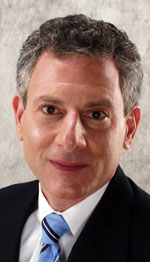 SAN DIEGO --It sounds like a great idea. Provide some middle class relief by cutting out the federal gasoline tax during the summer months. This is when so many families take their annual vacation driving to relatives or to a national park. As gas prices continue to rise, the remaining major presidential contenders have spoken out about a “Gas Tax Holiday”. This is the idea being pursued by Senator John McCain and Senator Hilary Clinton as they continue their pursuit of the presidency. It’s a very populist notion that should appeal to middle class and lower class voters. SAN DIEGO --It sounds like a great idea. Provide some middle class relief by cutting out the federal gasoline tax during the summer months. This is when so many families take their annual vacation driving to relatives or to a national park. As gas prices continue to rise, the remaining major presidential contenders have spoken out about a “Gas Tax Holiday”. This is the idea being pursued by Senator John McCain and Senator Hilary Clinton as they continue their pursuit of the presidency. It’s a very populist notion that should appeal to middle class and lower class voters.
I remember many summers when I was little driving from our home in New Jersey down the eastern seaboard to historical sites like Monticello, Gettysburg and Fredericksburg. One summer, we drove up to Quebec. Wow, how costly it would be to take those kind of trips today. Tax relief sounds like a good idea.
 There is problem: it’s called market forces. The price of gas is as high as it is because we are willing to pay it. The basic laws of supply and demand are governing the price of gas. For many years, a president or powerful member of Congress was able to quietly lobby producers – domestic and foreign – to keep the price of gas at a certain level. There is problem: it’s called market forces. The price of gas is as high as it is because we are willing to pay it. The basic laws of supply and demand are governing the price of gas. For many years, a president or powerful member of Congress was able to quietly lobby producers – domestic and foreign – to keep the price of gas at a certain level.
In July 2006, the American Jewish Committee published a report on our dependence on foreign oil. That report showed that Over 65 percent of our oil consumption is based on foreign sources of oil. During the oil embargo of 1973, we used only 36 percent of our oil from foreign sources.
The number of vehicle miles traveled on US roads has tripled since the 1970’s. In all likelihood, the “reduction” in price due to a “gas tax holiday” would be eaten up by the increase in demand during the peak summer driving period.
Many republicans legislators support drilling in the Arctic National Wildlife Refuge (ANWR). But drilling in ANWR would produce domestic oil only beginning in 2013 and the peak would be reached in 2025 with a production rate of 876,000 barrels a day. That means that instead of the projected 70 percent of oil usage coming from foreign sources, we would have 63 percent as determined by the Energy Information Administration.
As the San Diego Union Tribune reported, when Illinois and Indiana suspended about 7 cents of their state gas taxes in the summer of 2000, prices fell by an average of only 4 cents, according to a study by the American Road and Transportation Builders Association, which opposed the plans. Drivers saved no more than $2.50 a month, while each state lost tens of millions of dollars in tax revenue.
The AJC has a novel approach, a new twist on “put up or shut up.” Since its report on our dependence on foreign oil, AJC has offered rebates to its employees who purchase hybrid vehicles. While that reduces demand to some extent, the only real solution to our dependence on foreign oil is to encourage, purchase and use vehicles powered by other energy sources.
While the hydrogen highway is on the drawing board, the electric car is a more viable option. General Motors should make the Volt available 2010. Right now, Tesla Motors and Phoenix Motors both offer electric vehicles, pricier than conventional gasoline powered vehicles, but devoid of the gasoline engine. Toyota is testing a plug in Prius that would use the gasoline engine as a back up. Now, if you can produce your own energy, you would have significant monthly fuel cost savings. That is where solar panels come in. You put the panels on your roof top, produce the energy that would repower your electric car and voila, no more monthly fuel bills.
So rather than a tax holiday, Congress should rechannel the income tax rebate to become a new tax credit for solar panels and hybrid or electric cars. This would be a solution that increases our national and personal independence and enhances national security. We might actually funnel funds into a domestic product, putting US workers back to work, rather than using the tax rebate on more products that are made in China and shipped to us using foreign oil.


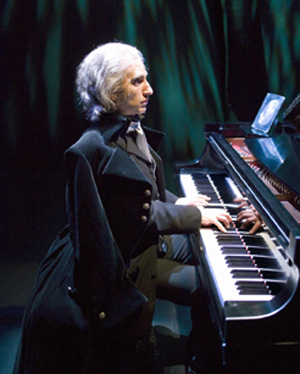 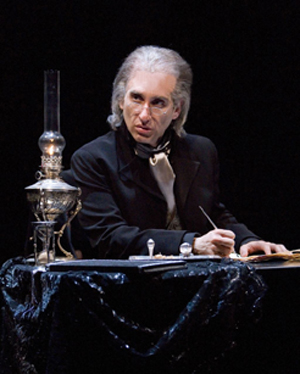
Felder portrays Beethoven the man and Beethoven the musician at Old Globe
By Eileen Wingard
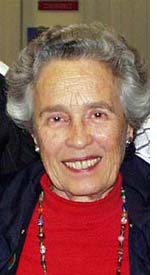 SAN DIEGO--Hershey Felder provided a magical evening of theater and classical music in the Thursday evening, May 8, presentation of Beethoven As I Knew Him at the Old Globe Theater, which will continue to be performed through June 8. He filled the roles of playwright, concert pianist, actor and singer with remarkable skill. SAN DIEGO--Hershey Felder provided a magical evening of theater and classical music in the Thursday evening, May 8, presentation of Beethoven As I Knew Him at the Old Globe Theater, which will continue to be performed through June 8. He filled the roles of playwright, concert pianist, actor and singer with remarkable skill.
The Montreal-born Felder was a piano prodigy who performed in Canada’s
Yiddish Theater circuit. Among his original compositions is Aliyah, Concerto for Piano and Orchestra. His recordings include Love Songs of the Yiddish Theater.
Felder’s two previous one man plays, George Gershwin Alone and Monsieur
Chopin, received acclaim on both sides of the Atlantic. Beethoven As I Knew Him completes the trilogy of plays which the writer entitled Composer Sonata.
The multi-talented Felder based Beethoven As I Knew Him on occurrences
during the last two years of the composer’s life, yet deftly wove in recollections of previous years and earlier works, beginning with the performance of a set of variations which Beethoven wrote at the tender age of eleven. Most of the time, Felder portrayed Gerhard von Breuning, Beethoven’s student, the
narrator for the story. Felder also played Beethoven himself and, in one instance, Mozart.
The 90-minute theater piece included Felder at the piano for selections from the Moonlight and Appassionata Sonatas, and recorded music playing the orchestral accompaniment for Felder’s excerpts from the Emperor Concerto. Also heard are recorded sections from the Fifth and Ninth Symphonies and the Grosse
Fugue for String Quartet.
At some points, Felder spoke while playing, using the music as background to the narrative. He described Beethoven’s unfulfilled love life against poignant passages from the Moonlight Sonata, and related Beethoven’s misfortunes and volatile nature during the Appassionata Sonata.
The play described the tragedy of Beethoven’s relationship with his ne’er-do-well nephew Karl and his uncaring younger brother Johann whose neglect led to Beethoven’s final demise.
Although the stage had only a piano, a writing table and a couch, projected backgrounds created scene changes from Beethoven’s apartment to the concert hall to the final notes of the Ninth Symphony set against a sky full of stars.
As an actor, Felder spoke German and German accented English with authenticity. His singing of the "Ode to Joy" from the Ninth Symphony and of the "Lacrimosa" from Mozart’s Requiem added a welcome dimension, and his pianistic ability was equal to many a pianist on today’s concert stage. He played with
deep feeling, lyrical line and a vast continuum of dynamic contrasts.
Felder added a "coda" with information about Fresno State University’s acquisition of two bones from Beethoven’s skull. This might better have been left as written program notes, because it felt anti-climactic. However, Felder concluded with Beethoven’s most familiar piano piece, Fur Elise, an ideal
ending. The overflow audience rose in a standing ovation for the ingenious performer and playwright, Hershey Felder as he pointed to the projected sketch of Beethoven.


REFLECTIONS
A 'New Look' is something I don’t need
By Sheila Orysiek
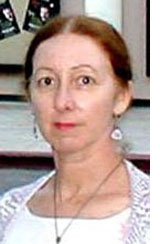 SAN DIEGO—The Torah tells us that the Patriarchs in Genesis lived to very ripe old ages. While this initially seems like a good idea, there have been times I’ve had my doubts. Even though I am not as yet 120, there are instances - increasing by the day - when the world seems to have passed me by. SAN DIEGO—The Torah tells us that the Patriarchs in Genesis lived to very ripe old ages. While this initially seems like a good idea, there have been times I’ve had my doubts. Even though I am not as yet 120, there are instances - increasing by the day - when the world seems to have passed me by.
The image I see in the mirror these last couple of decades is fragmented. This is because I have learned to look only at the part of my face I need to see. If I want to see my eyes, I look only at them. This method softens the impact of the handiwork done to my image by the passage of time. But, there did come a day when I decided that a visit to a cosmetic counter might be overdue. Besides, my supply of lipstick was running low and so off I went to a major department store in the mall.
Arriving at the store I remembered that this cosmetic department didn’t have Estée Lauder (a Jewish owned company and the one I usually patronize) thus I decided to try another company and found myself facing a brand new addition to the sales staff. It was rather surprising to find a fresh faced young man offering to help me.
He was less than one third my age; but way ahead of me in jewelry. Within his smiling lip was a small gold ring. It matched perfectly the one in his ear and the other near his eyelid. I didn’t readily reply to his greeting because I was distracted by the large ring through his nostril. My mind was caught up wondering how he blew his nose and hoping I wouldn’t get to witness a sneeze. I realized immediately he outclassed me in every way. Not only was his skin smoother, he was more smartly dressed and even his pony tail was longer than mine and since my hair was long enough to sit on, his apparently had never been cut since the day he was born.
 I had not only come to buy lipstick I had also been considering a moisturizing face cream (in the false expectation any thing would help). But how could I tell this young man that on the (slim) chance that my skin might begin to crepe I wanted to retard its progress? As I visualized myself trying to explain about small crinkles to this young lad I decided to stay with lipstick. I had not only come to buy lipstick I had also been considering a moisturizing face cream (in the false expectation any thing would help). But how could I tell this young man that on the (slim) chance that my skin might begin to crepe I wanted to retard its progress? As I visualized myself trying to explain about small crinkles to this young lad I decided to stay with lipstick.
I held up my old tube and asked for a replay of the same color. “Oh no!” said he (in a properly shocked voice), “we have a whole new spring collection.”
“I don’t want a spring collection,” I answered, “I want to stick with the tried and true.” He was very surprised, but proceeded to show me colors that looked fine to him, but were various shades of gothic black and brown to me. I didn’t have the courage to tell him those colors would make me look green. Not “younger than springtime green,” but pond scum algae green.
He carefully explained that the new spring colors were in the mauve “palette” - “house of mauve” he called it. Well, I told him my skin tone doesn’t change with the seasons so unfortunately for me, I need to stick with the same “house of whatever” color I already had no matter what the season.
He looked puzzled and asked: “You wear the same lip color all year?” How could I possibly break the news to him that I not only used the same lip color all year - but, every year, year after year. And, not only did my skin tone not change with the seasons - but my eye color also stayed the same. Brown eyes - all year long; for decades, actually. He would have had difficulty visualizing decades - he barely had equity in two.
I toyed with the idea of telling him that when I was born Roosevelt was president (no, not Teddy), but then I remembered how history is taught in our schools and realized he probably had never heard of either of the Roosevelts. I was really tempted to tell him I had known Washington - but the chances are he hadn’t heard that name either. (I’ve certainly known master degree graduates who don’t realize Washington’s birthday is NOT the third Monday in February).
Next he looked down at my hands. Involuntarily my fingers curled out of view. I knew he was wondering why I hadn’t painted my nails a “with it” brown but had instead sprinkled brown spots on my skin. He was obviously sadly disappointed in the prospects I presented as a customer. However, he gave me one last chance and asked if I was interested in a “new look." How could I possibly convince him that I was just trying to preserve the old one?
He had two answers to every question or statement: “cool” or “no problem.” It made me wonder what could possibly cause him to see everything as “no problem” as here I was standing before him - a living problem. Ah - the optimism of the young. Of course, he was oblivious to the fact that to me “he” was the problem.
Whose idea was this anyway to hire a young man in the women’s cosmetic department? Is this someone’s version of politically correct egalitarianism? If the Equal Rights Amendment had passed this would be enough to make me want to have it repealed. I can’t wait till this young man or his like shows up in women’s lingerie.
He - or his double - did turn up one day at the Barnes and Noble book store and when I asked him where I might find books by Nobel Laureate author Isaac Bashevis Singer he responded by asking me if the author was dead or alive. This seemed strange; I didn’t think authors were shelved by their state of mortality.
“Dead,” I said.
“Oh,” says he, “we don’t have books by dead writers.”
“Uh,” I hesitated to ask him, “you don’t have any Shakespeare, or Bibles, or Dickens, or Maugham, or Austin, Alcott, Twain, Ferber, Dreiser, Churchill, Gibbon, Franklin, Hawthorne, Scott, Bronté, Kipling, Tolkien, Tolstoy, Dostoyevsky, Plato or …?” He looked puzzled - he’d never heard of those dead guys and gals.
Another version of this twenty-something age group came into my life when a covey of young hair stylists walked into ballet class. They were in San Diego for a convention and were looking for volunteers to act as models for their hairdo creations. Being one of the older dancers in class, I assumed that I was of no interest to them - there were lots of young beautiful women in class. However, when my hair was not tightly contained in a bun, it hung well below my waist - and this was a red flag which instantly caught their eye.
All of them told me that they would LOVE to have me come to their convention so that they could work on my “head” (they don’t use the word “hair”) and I would be thrilled with the result - it would all be free - in fact lunch was included! They went to considerable effort to tell me what a unique opportunity my long hair presented. I refused - they were stunned - sad - depressed - in agony. How could I possibly refuse this marvelous opportunity to see what wonders their artistry could produce on my “head?”
By way of explanation, I asked them one question: “What is the first thing you are going to do to my long hair? I bet the first thing you will do is cut it.” They all nodded happily - yes, they would. So, I said: “Why don’t you save yourself the trouble and find someone with short hair?” Obviously I don’t connect well with the generations born much after Roosevelt was president.
But even worse was the day I walked into the doctor’s office for my yearly checkup to be confronted by a twenty-something male receptionist - not a male nurse - but a male receptionist - intent on quizzing me on my intimate physical data for the year. I don’t care under what paradigm he was hired - it was time to switch doctors. That was easier than switching lipsticks or finding a book written by a dead author.


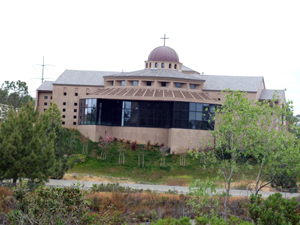 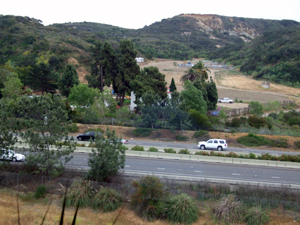
THE JEWISH CITIZEN 'A Jewish Story Eveywhere'
Chabad Jewish Center, St. Therese Catholic Church share history, but not theology
By Donald H. Harrison
 SAN DIEGO—Across California Highway 56, between the Carmel Creek Road and Carmel Country Road exits, two houses of worship are in view of each other’s back yards: Chabad of Del Mar and St. Therese of Carmel. SAN DIEGO—Across California Highway 56, between the Carmel Creek Road and Carmel Country Road exits, two houses of worship are in view of each other’s back yards: Chabad of Del Mar and St. Therese of Carmel.
Besides by a freeway, these two institutions are also separated by wide theological differences. Members of Chabad, a Chassidic Jewish institution, typically refrain from using the words "Saint" or "San" so as not to imply acquiescence to the Christian concept of sainthood, which to many Orthodox Jews smacks of forbidden idolatry. It is not uncommon for Chabad members to refer in writing to the city in which they live as “S. Diego” rather than “San Diego." The name "St. Therese" poses a similar theological problem forthem.
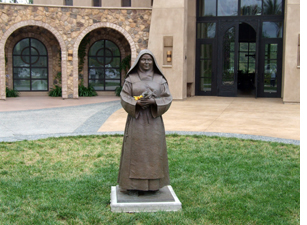 St. Therese of Carmel Catholic Church was named in memory of Therese Martin, a 19th Century French nun of the Carmelite order, whose short life was considered so exemplary that she was canonized as a saint. She died of pneumonia in 1897 at the monastery in Lisieux, France, when she was only 24, but her reflections on how one can serve God have inspired generations of Catholics who followed her. St. Therese of Carmel Catholic Church was named in memory of Therese Martin, a 19th Century French nun of the Carmelite order, whose short life was considered so exemplary that she was canonized as a saint. She died of pneumonia in 1897 at the monastery in Lisieux, France, when she was only 24, but her reflections on how one can serve God have inspired generations of Catholics who followed her.
“I am a very little soul, who can offer only very little things to the Lord,” she is quoted as saying by Wikipedia. “I will spend my Heaven doing good on earth. After my death I will let fall a shower of roses.” A statue of St. Therese of Carmel in front of the large church shows her with flowers in her hand, a reference to her reputation as the Little Flower of Jesus.
Yet, for all their theological differences, St. Therese and Chabad of Del Mar have some shared history as well.
To begin with the Carmel Valley area was named after Mount Carmel in Israel, near Haifa, where the Bible teaches that the Prophet Elijah demonstrated the power of God over that of the pagan deity Baal, notwithstanding that he was outnumbered 450-1 by Baal’s priests. (I Kings 18:21-40)
It was on that mountain, near a place known as the Well of Elijah, that Catholic monks established in the 12th century C.E. the Stella Maris Monastery. As the order grew it established monasteries in other countries around the world, and eventually orders for women also were created.
In the 1890s, the Sisters of Mercy—an order that considered itself a cross between the cloistered Carmelite nuns and the Sisters of Charity—purchased 1,000 acres from the McGonigle family and named their acquisition Mount Carmel Ranch. There they developed a dairy and a pig and vegetable farm for the benefit of patients at St. Joseph’s Dispensary in San Diego—an institution that eventually would evolve into Mercy Hospital.
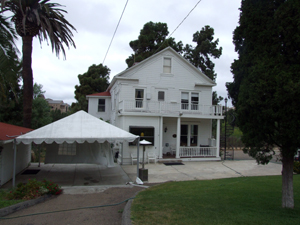 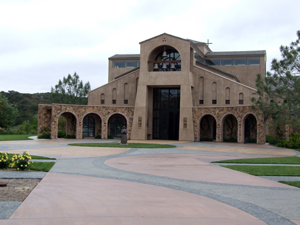
The sisters had a home built in 1905 to serve not only as their living quarters but also as a refuge for orphans. Between this time and 1947, when Robert and Ann Stephens purchased the home, the area became generally known as Carmel Valley.
The Stephens family helped to found St. William of York Catholic Church, the forerunner church of St. Therese of Carmel Church. Before the freeway was built, a bridge used to connect the Stephens' property with a cemetery where the nuns were buried, adjacent to the church. When Mrs. Stephens died in 2003, her estate sold the property for $1.15 million to Chabad of Del Mar, which had been conducting services in Del Mar—a separately incorporated city that lies to the west of the Carmel Valley section of San Diego.
The congregation, under the spiritual leadership of Rabbi Hersh Piekarski, reads Torah on Monday and Thursday mornings at the home on the historic property. However, Shabbat services which draw a larger crowd are held in an assembly room of the nearby San Diego Jewish Academy on Carmel Creek Road.
In summary: Named for an area made famous in Jewish Scriptures, Carmel Valley was settled by a Catholic order which eventually sold its property to a private citizen who helped establish the church across the freeway. After she died the historic home became property of the Chabad Jewish organization. There may not be a concrete interchange over the freeway at this location, but there certainly is a religious interchange.

ADVENTURES IN SAN DIEGO JEWISH HISTORY
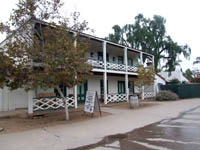
Robinson-Rose House
|
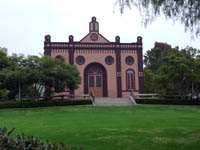
Old Temple Beth Israel |
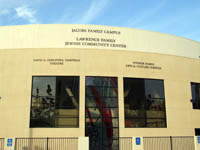
Lawrence Family JCC |
Editor's Note: We are reprinting news articles that the Southwestern Jewish Press ran in 1950. If you have historical topics about the San Diego Jewish community you would like us to explore, please e-mail your suggestions to editor Don Harrison at sdheritage@cox.net
Memorial Planned for Rabbi Moise Bergman
From Southwestern Jewish Press, June 23, 1950, page 6 {Illustration}
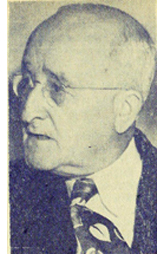 Funds are now being raised to establish a memorial in memory of the late Rabbi Moise Bergman {pictured at right}, former spiritual leader of Temple Beth Israel. The memorial will be in the form of the rebuilding of the Temple Altar and other parts of the Synagogue. Funds are now being raised to establish a memorial in memory of the late Rabbi Moise Bergman {pictured at right}, former spiritual leader of Temple Beth Israel. The memorial will be in the form of the rebuilding of the Temple Altar and other parts of the Synagogue.
For the past two years the Congregation has been slowly accumulating money for this project and now the Temple Men’s Club has organized to raise the amount needed to realize this worthy program.
During his term of service here, Rabbi Bergman served the entire community and never rejected a call for assistance from any part of the religious community. It is therefore felt that many members of the community, whether they hold Temple membership or not, would wish to contribute to the altar in his memory.
Leon Heiman, member of the Board of Temple Beth Israel, has been appointed coordinator of this project. Anyone wishing to contribute to the Altar Fund may call the Temple at T. 9-4631 or send a check to the Secretary of Temple Beth Israel, 3rd and Laurel Streets.
It is hoped that the new Bergman Memorial Altar will be ready for use for the High Holy Days. This will only be possible if enough onies are raised to insure its completion.
‘Council House’ to Close: Served Purpose Say Leaders
From Southwestern Jewish Press, July 7, 1950, page 1
After ten months of lifesaving operation, “Council House” will be closed, according to a joint announcement of the san Diego Section of the National Council of Jewish Women and the “Émigré Committee” of the United Jewish Fund.
“Council House, established jointly by the Fund and the National Council of Jewish Women, has completely served its purpose,” Maryon Doctor, President of the Council’s San Diego section, said last week.
“At a time when the need for shelter for ‘New Americans’ was most vital, the Council of Jewish Woman and the United Jewish Fund organized, directed and operated Council House. Today, it is the feeling of the organizations involved that there is no further need for the group shelter, and therefore in the best interest of the newcomers we seek to serve, and of our community, we feel that the house should be closed.”
Women of the Council will assist in arrangement of individual housing for families now living in Council House.
Mrs. Doctor stated that the move in closing Council House is in keeping with the principle that when a Welfare Service has served its purpose, it should be ended, and no attempt be made to expand its services so that it may stay in existence. Council will continue to operate the Thrift Shop as a project to assist newcomers in our community, both for clothing and employment.
Temple Beth Israel Reveals Plans for New Altar
From Southwestern Jewish Press. July 7, 1950, page 6
 It was revealed today by the Board of directors of Temple Beth Israel that contracts have been let for the construction of the Bergman Memorial Altar. Milo Berenson, prominent local builder, has been awarded the contract, which culminates nearly two years of careful planning to establish a perpetual memorial for the late, beloved spiritual leader. It was revealed today by the Board of directors of Temple Beth Israel that contracts have been let for the construction of the Bergman Memorial Altar. Milo Berenson, prominent local builder, has been awarded the contract, which culminates nearly two years of careful planning to establish a perpetual memorial for the late, beloved spiritual leader.
The altar will mark a new departure in design, in that it incorporates the newest ideas in synagogue construction, combining the utilitarian with traditional dignity. A rich walnut paneling on the rear and sidewalls of the altar forms a striking framework for the dramatic treatment of the Ark. Unusual, concealed lighting effects will highlight the magnificent, 30-foot, glass-spun draper of the Ark. Worshippers will enjoy an unobstructed view of the entire altar, since the Menorah shaped twin pulpits for the rabbi and Cantor will be at the two sides. Enhancing the sanctity of the altar will be specially designed hand-wrought brass candelabra and eternal light; built-in settees, sound system and planted boxes bearing the perennial tropical plants. The choir loft will receive an unusual treatment with a visible choir in vestments.
Many magnificent contributions, memorializing loved ones already have been received. However, there remain several appurtenances that have not yet been spoken for. Information regarding these may be obtained by calling the Temple Office, F.9-4631. Members of the Congregation—and of the community who revere the memory of Rabbi Bergman—are invited to make their contribution immediately. Whther large or modest all gifts for the altar will be welcomed.
According to Rabbi Morton J. Cohn, who urged the building of the altar nearly two years ago, this fine improvement will enhance the beauty of worship during the approaching High Holy Days.

SAN DIEGO JEWISH WORLD THE WEEK IN REVIEW
Shoshana Bryen in Washington DC: Naqba, or catastrophe, is propaganda; truth is Palestinians' self-imposed victimhood
Ulla Hadar in Kibbutz Ruhama, Israel: Mortar kills Kfar Aza man in his garden
Donald H. Harrison in San Diego: Jewish-named places in San Diego's news
Rabbi Baruch Lederman in San Diego: The Rosh Yehsiva's love for his talmadim
Sigal Shalev Peres in Hazeva, Israel: A Yom Ha'atzma'ut party to remember
Rabbi Leonard Rosenthal in San Diego: Some guidelines for synagogue dress
Ira Sharkansky in Jerusalem: Olmert inquiry focuses on dealings with American fundraiser Moshe Talansky
Adventures in San Diego Jewish History: What was the Jewish community news in 1950? Who were the newsmakers? Our archives answer these questions in daily installments
Shoshana Bryen in Washington DC: Israel at 60 continues to bend over backwards to accommodate neighbors
Cynthia Citron in Hollywood: Credit Sweetest Swing in Baseball with RBI
Ulla Hadar in Kibbutz Ruhama, Israel: Austria's president tells Israeli delegation of his sympathy for Sha'ar Hanegev residents
Donald H. Harrison in San Diego: Hebrew Day takes virtual tour of Israel
Sheila Orysiek in San Diego: Chapter Seven in the serialization of her novel, Reluctant Martyr
Adventures in San Diego Jewish History: What was the Jewish community news in 1950? Who were the newsmakers? Our archives answer these questions in daily installments
Shoshana Bryen in Washington, D.C.: King Abdullah points out Rice's folly
Donald H. Harrison in San Diego: SDJA students, faculty join worldwide quest to be largest group singing at the same time
Rabbi Dow Marmur in Toronto, Canada: Oh, Canada: Do you honestly think that Jerusalem is not a real part of Israel?
Sheila Orysiek in San Diego: The day that Israel became a nation
Cheryl Rattner-Price in La Jolla, California: JCC features work of 8 women artists
Hal Wingard in San Diego: His song, "Noah"
San Diego Jewish World staff in San Diego: Jay Winheld, CPA and Jewish volunteer, dies at 71.
Adventures in San Diego Jewish History: What was the Jewish community news in 1950? Who were the newsmakers? Our archives answer these questions in daily installments
Judy Lash Balint in Jerusalem: The anticipation of Yom Hazikaron
Donald H. Harrison in San Diego: San Diegans and Israelis join in their grief for the casualties of war and of terror
Evelyn Kooperman in San Diego: San Diego Jewish Trivia: Authors
Cantor Kathy Robbins in Cardiff-by-the-Sea, California: Im Tirtzu: Hold Fast to Dreams
Adventures in San Diego Jewish History: What was the Jewish community news in 1950? Who were the newsmakers? Our archives answer these questions in daily installments
Donald H. Harrison in San Diego: Marketing Middle East peace through the products offered in Western supermarkets
Dov Burt Levy in Salem, Massachusetts: Comfort for the bereaved on Yom Hazikaron and year round: the gift of active memory
J. Zel Lurie in Delray Beach, Florida: Let us look at Israel‘s Declaration of Independence as its 60th birthday nears
Joel Moskowitz in La Jolla, California: A dybbuk that teaches righteousness
Adventures in San Diego Jewish History: What was the Jewish community news in 1950? Who were the newsmakers? Our archives answer these questions in daily installments
< BACK TO TOP
|
|
